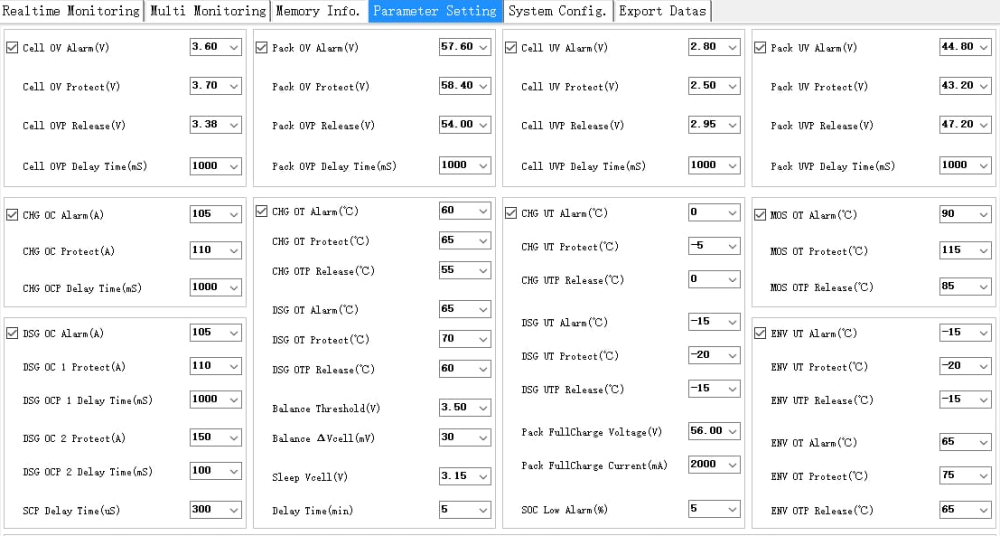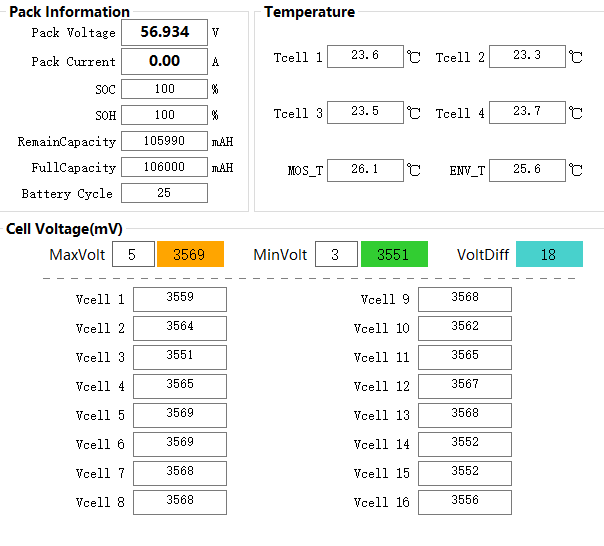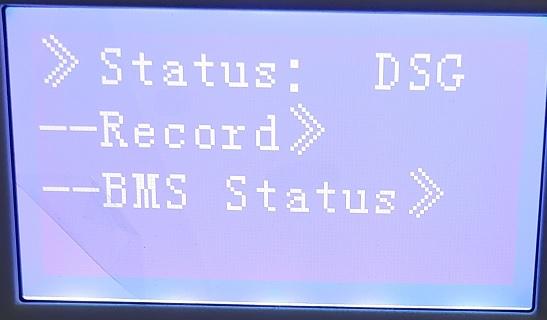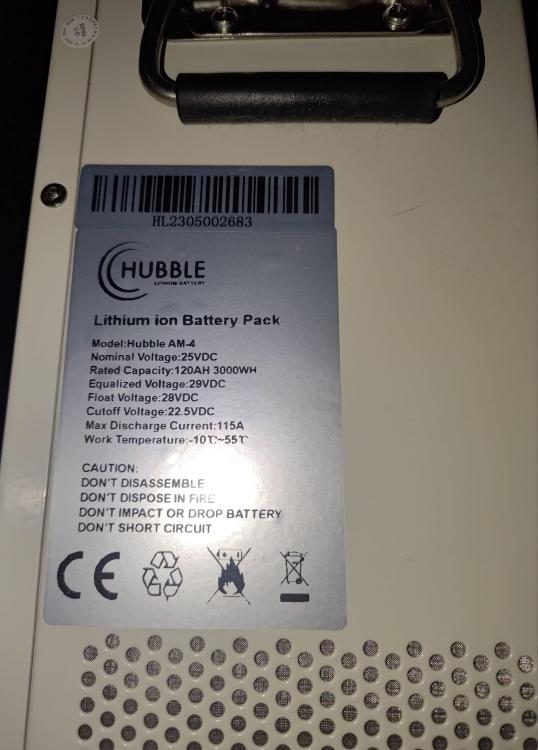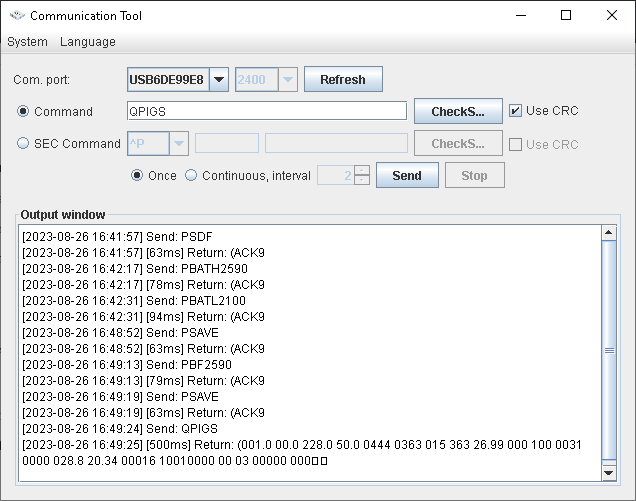Search the Community
Showing results for 'Battery Balancer HA12 Bluetooth'.
-
This is a warning to those kind folk out there that want to buy battery systems. I received a 100A JK bms connected to 16 100A cells for a very good price This comes from a reputable company in Pretoria. I have dealt with them regarding lead acid batteries and have not had any issues with them. But my goodness the lithium side of the business definitely needs some work. The bms was setup as follows. Cell OVP 2.7V SOC 100% 2.68 CELL OVPR 2.65 CELL UVPR 1.85 SOC 0% V 1.82 CELL UVP 1.8 I believe that if I leave the bms at these settings I will get to use about 20% of the battery and run it bellow the manufactures limits. This is just a warning to those out there wanting to go semi DIY Iike I am. After chatting with one of the members at the business I was given the "correct" settings and the password of 12345 (without the 6). That password obviously did not work lol. I was also informed that going outside the new specs that where given will invalidate my warranty. Needless to say I will be invalidating my warranty big time. Do not ask I will not mention the company. I will be using the settings as set out by Off grid garage on youtube Rant over
-
Hello, I have an Eco Worthy 24V 100Ah lifepo4 battery and a Vevor 3.5KVA inverter/charger system. I have tried to charge it at 35A and 20A rates with AC source, but after less than an hour, the charger drops the current down to 0-1A as if the battery were almost full, but it seems that the battery never gets charged well. The charge and floating voltages of the charger are set to 28.8V. The last time, the Vevor system charged it at 20A for only 50min and then goes down. The initial voltage of battery was 26.3V and, after charged it and leaving it for some time, the voltage was 27v disconnected. In addition, when I connected it back to the inverter system, after 15min the voltage dropped from 27 to 26,5v. The voltage vs SOC table of this lifepo4 battery is different for what I have seen in the forums and I've never been absolutely sure about the state of charge of the the battery Any idea of what is happening? why does the charger is not charging it for more time?
-
-
Batteries. A rather important and crucial part of a residential solar system, especially here in South Africa. I was originally going to go the DIY route and even purchased some 184ah Svolt cells with the BMS and all other accessories necessary although something came up which lead me to sell the cells, skip the DIY batteries for now and look at purchasing already built batteries – this is where the Svolt 106AH batteries come in. When I found out Svolt had an office open up in South Africa and they were selling batteries locally, my interest was naturally piqued as I already had some of their 184ah cells. Svolt is also a rather large company and they make cells for the EV market as well and Svolt will be supplying BMW with cells for their EVs in the future, along with CATL & Eve Energy. Before I continue I want to state that I do not have any affiliation with Svolt. I do not work for them, I paid for all of my batteries, I do not get any kickbacks from them – nothing. I am just a client of theirs. After reaching out to them and getting more info, I was invited to their Johannesburg office to view their batteries and other products (inverters). I had a brief chat to the guys and decided to purchase one of the 16 cells 106AH batteries to try out and see how it performs. Taking it out the box, the battery looks really nice, the wall mount is simple yet effective, it comes with a nice set of cables and the crimps seem to be done well (as expected), the power connector which is used for the battery is very convenient and easy to connect / disconnect the cable from the battery. Unfortunately I did not take pictures and mine are already connected, I do not really feel like disconnecting everything to take pictures but if you guys would like some pictures then let me know and I will make a plan to take some. The battery has a nice button to turn it on/off and a screen to display some info from the BMS and once can easily navigate through the menu with the buttons. Here is the Svolt catalogue which has the specifications for the batteries: https://www.dropbox.com/scl/fi/69c9wnxrklmhc4xg9nn6c/Svolt-Battery-and-Inverter-Catalogue-20230803.pdf?rlkey=z8q9we55gzzs31e9wh3tw5ahp&dl=0 I believe all the batteries make use of a Pace BMS. The Pace BMS is very popular with pre-built batteries and are used in many different brands of batteries. Andy from Off Grid Garage did a review one of the Pace BMS’s and you can watch it here: At first I had some issues getting the battery to talk to my Luxpower, however Svolt confirmed that their batteries do communicate with the Luxpower inverters as well as majority of other inverters (MUST, Conderenergy, Growatt, Sunsynk / Deye, Victron, Svolt, Luxpower and more). The BMS has different options which Svolt can change for you to ensure it works with your inverter. By default it is set to Pylon which works with majority of inverters. After reaching out to the Svolt guys and speaking to one of their technician staff, they decided to come through to my house to take a look and try figure out what the issue was – pretty impressive from a customer support point of view. Turns out it was a very silly mistake from my side, the dip switch was not configured properly (I left them all down as per the manual, where dip switch 1 should be in the up position). As soon as we did that, the comms started working – I had to use the battery without comms for a few days before Svolt came to my house and it worked well like this too. After getting the battery comms working I was finally able to use the battery as intended with communication to my inverter. The battery is 1C rated, with the communication it sets the max charge / discharge limit to 95A which is technically not the full 1C rating limit but it is close enough for me to not be bothered by it. 95A x 51.2v = 4 864W so just short of a full 5KW but if you were to have a 5KW inverter how often would you be running it at its limits when there is no grid? I was able to access the BMS info via PBMSTools and below is a screenshot of the parameters: I ended up purchasing 2 additional batteries, so that is 3 batteries in parallel and to get them connected in parallel is super easy. Adjust the dip switches as per the manual, connect them with the network cable supplied in the box and it just works. The BMS and inverter speak to each other and my limit now changes from 95A to 285A (as the limit is per battery, obviously keep in mind that you need to ensure the cables you use can handle the max current and obviously your inverter(s) too). Out of the box I did have the cells being imbalanced, however I am quite impressed that the BMS was able to balance the batteries. Since it does not make use of an active balancer it can take a bit of time but it did work and it did manage to get them balanced! At first I was a bit concerned that the BMS would not be able to balance the battery and while it was balancing I was concerned it would not charge to the correct voltage, when I reach out to Svolt they said if that does happen they will be able to assist me and if the battery was in such a bad state that it was not usable they would replace it with a new battery for me (once again, I feel this is really good from a customer care point of view). I have not had to have any batter replaced though. Below you can see a screenshot of the cell imbalances: Here is a screenshot after a week where the BMS has managed to get them balanced: Here is a screenshot I took at the same time of my older battery, as you can see the cells were balanced rather well: My oldest battery has a total of 44 cycles only, so still early days but so far so good and I would not hesitate to purchase more of these Svolt batteries. Based on my experience with Svolt customer support I am not worried about a valid warranty claim being rejected. The technical staff are knowledgably and actually know what they are talking about as well. Svolt are still new in South Africa, the pricing on these batteries have been exceptional however I am not sure whether the price will increase with time as they become more established, I suspect this might happen as I have seen this happen with other brands but time will tell. I hope this helps those who are on the look out for batteries. If there is anything in specific you'd like to know which I have not included in this review, let me know!
-
ACDC branded Axpert 5kW inverter BlueNova BN52V-100-5.2k BP Battery 22 Months old, both bought new from ACDC Will check cycles, but battery was not cycled daily as it was not used for solar. Combination carried a 4 bed house through stage 6 loadshedding. All connected except oven, stove, pool pump and geyser. Reason for selling: upgrading where I need inverter with more functions, and more than one same brand battery. (This one is not the cheapest new). Both for R15,000.
-
@HubbleLithium According to the sales data the Hubble AM-2 is a 5.5kWh 51V 100Ah battery: Nominal Voltage V x Rated Capacity Ah = Wh 51V x 100Ah = 5100Wh or 5.1kWh Q1. What is the "5HR" mean in "Rated Capacity 5HR"? A. See http://support.rollsbattery.com/en/support/solutions/articles/216766-what-is-amp-hour-capacity- Ah is normally determined over 20 hours, unless otherwise specified. For AM-2, 100Ah / 5hr or 20A continuous for 5 hours - which compared to Lead Acid is very good. Lead Acid batteries suffer from "Peukert Effect". Lithium batteries suffer much, much less - See https://battlebornbatteries.com/peukert-effect/ Q2. Is the Hubble Lithium AM-2 a 5.1kWh battery or a 5.5kWh battery?
-
Does anyone have experience with the Nenergy 12v, 100Ah battery? I would like to know. 100Ah Nenergy 1.28KWh 12V Lithium-ion LiFePo4 Battery | Buy Online in South Africa | takealot.com Thanks, Peet
-
Hi Team, I was reading quite a bit around setup of the MUST inverters. I would like to ask some questions, maybe you can give me more light in to the darkness... 1. I want to have a SbU (1) - Solar/Battery/Utility setup 2. I like to use Solar power first on loads and after charging - LBU (5) 3. I want to charge the batteries only with solar power - OSO (10) 4. And if on top of the load and the battery charging I will have some energy left I want to send back to the grid - GRE (9) For battery I have information from manufacturer LiON (14cellls - 3.3V cutoff and 4.1V max, 46.2V cutoff and 57.4V max) My setup is: 17-57.3V, 18-57V, 19-46V, 20-47.5V, 21-54V My issue is, when I set up GRE (9) -> it will check with LBU setup parameter 20 and if it is higher than 47.5V start to feed solar and battery power back to the grid. Which is not my intention to do. Do you have any recommendation? Or any idea what could I set up differently(LBU/BLU)? Or maybe I'm completely wrong? Thank you!
-
My Nomad 80 Regulator / Solar Charge Controller has failed being less than 2 years old. A "Ground Fault" error is displayed and the solar power is disconnected. The manual calls for the replacing of a 600mAh fuse which I have checked with a continuity meter and there is continuity. I cannot see that the fuse wire between the fuse caps is broken. There are no burn marks which can sometimes be seen when a fuse blows. I have logged a fault with the installers this morning (09:50) and there is no response so far as of 13/05/2024 14:10 The eTracer was replaced by the Nomad when I did an upgrade (Solar Charge Controller, Freedom Won 10/8), and fed 4 x Nerada 150Ah batteries (48V) at the time. Can the eTracer be used as a work around while the Nomad is being repaired, if not a permanent solution. The Nomad was selected as the long-term plan is to add another 3kW solar panels which the eTracer cannot support - only has one port at 60A. From reading the Freedom Won documentation, it appears that I need a cable (CAN BUS?) between the Freedom Won and the solar charge controller and this cable needs a specific pinout. The eTracer documentation (attached) is not great. From the document, it has a Remote Temperature Sensor Port (MC1.5-3.81-2l) and a CAN Bus Port (MC1.5-3.81-2l) It is not clear from the photo which is the CAN BUS port, as there are lables for RS-485 and RS-232. The Battery Remote port can be seen. There is also a pin out for on a lable, but it is not clear if this refers to the "New Features Interface Reserved" Do I need a cable between the Freedom Won and the eTracer assuming that I can use the eTracer? eTracer ET6415BND Regulator.pdf
-
Hi all A friend started having trouble with their setup, they have 16 100. Ah AGM batteries, aranged in 4 parallel banks each with 4 batteries in series and the system just doesnt hold much longer than an hour with around 300 or so watts of load on the system. We connected solar assistant to his system to at least see what’s going on the battery spec sheet lists a float voltage of 13,5v per battery and with 4 in series the batteries seem to be “starting” off charged at the right voltage As per the voltage graph below, the batteries run like this for a short while then there is a sudden steep drop in voltage it runs a while longer then another steep drop below the configured working voltage and the system reverts to grid. To me this looks like one or more batteries in his bank is “tired” (they are 18 months old, but I also can’t speak to weather they were charging properly etc during those 18months) pending a load test on each battery though could someone comment on weather my thinking on weak batteries is likely? thanks
-
https://techcentral.co.za/south-africa-lithium-battery-recycling/244440/
-
Dear PowerForum users, I wanted to ask for some advice, please. I have a Deye 5kW inverter with two Dyness BX51100 5kW batteries (200Ah) running perfectly for the past year. My Deye inverter is set to 200Ah on the battery setting. My installer installed another Dyness BX5110 today, so now I have three of the exact same batteries with a total of 300Ah battery capacity. My installer said that on my Deye inverter settings the battery must not be adjusted to 300Ah, it must stay on 200Ah. He spoke to his distributor to confirm this setting. Is this best practice? Insights on this will be much appreciated.
-
Hi all, I'm sitting with the issue of unequal charge on my 3 x Dyness BX51100's. This morning the SoC level reported by my inverter was 30%, 1 LED on the master(+/- 20%), 3 LEDs (+/-60%) on slave 1 and 2 LEDs (+/-40%) on slave 2. How would I go about in equalising the charge/discharge on all 3? Should I remove comms, charge each one on it's own to 100% and then reapply comms? I only started experiencing this issue after I changed the comms cables to the correct ones to correct max charge & discharge currents on the BMS. Prior to this, the inverter only allowed 50A max charge/discharge currents and not 50A x N, where N is number of batteries. Deye 8kW inverter 3 x Dyness BX51100, parallelled on a busbar 14 x 550W JA Solar panels
-
Need some ideas / help where I might have done wrong Just installed HV system sunsynk batteries with a 50kw inverter working with a generator no grid connected to it Since I stalled batteries trips(BMU) like each and every week and have to go and reset the battery manually, it does not come back on its own Sunsynk techs have been coming to site and they talk of firmware updates on the inverter side, they have been putting and reversing the updates but it does not help What can be the solution to this because the customer is loosing his patience or where do I check Any suggestions,
-
on my MUST hybrid inverter; If my battery runs out and results in a fault "battery voltage is too low", my expectation would be that after the sun comes and starts charging again via solar, the inverter should be able to switch itself on again. This is not happening and I am not able to configure this desired behavior via the settings. any ideas?
-
Morning all! Happy New Year!! I'm new on the forum and have recently upgraded my system from just a battery back up (Synapse 5kw inverter and 4 x 100AH lead acid batteries) to PV with a Greenrich 5KW battery using old Synapse inverter. This system has it's limitations but serves my needs for now. The question I have is, where/how can I dispose of the old batteries? I'm in the Randburg area of Joburg. Battery Centre Selby offered me R100/battery which seems quite low considering they're 30kg each.
-
Good day, This is the battery I bought: Hubble Battery I am bit worried concerning this battery. I bought it on the 20 February 2024 as my gel batteries were terrible. Got the electrician to come set it up and everything. I maybe used it 10 times or so as loadshedding actually disappeared for a bit. This battery has 6 lights that show battery level. So all 6 are always on basically since no loadshedding and usage. About a month or so ago I realized 1 light was off, I didn't pay to much attention as I rarely checked it. Last week I noticed 2 lights were off. I am very confused as to why this is losing battery life I presume if not even being used? or am I misreading the situation, I was thinking of calling the electrician to come out and check but just wanted to hear if anyone has experienced something like this before. I have attached pictures for the model and the lights I was talking about. Thank you
-
Does anyone have any experience with these batteries? Seems like a very good price if the 3000 cycles number is realistic. https://solarwarehousesa.com/products/conderenergy-tubular-200ah-battery-3000-cycles Conderenergy High Performance Solar Tubular 200AH Battery (Please note this battery can leak if it gets tilted ,we do not courier this item. Please collect or arrange your own courier at your own risk if this battery leaks please just refill it with distilled water) What is Tubular Battery? Tubular batteries are lead-acid batteries that are much larger than flat plate batteries. Tubular batteries are commonly seen in UPS and inverter systems. The tubular batteries have a positive plate nestled within a tube wrapped in cloth that holds its electrodes' power.
-
Hi Guys Have just done a video on adjusting your inverters battery settings based on the load shedding level being reported by ESP. You can customise as many different configurations as you want and switch between automatically based on the Load Shedding Level being reported by ESP. Please let me know what you think of the automation, am still working out how all this stuff works and not an expert by any means so all advise/suggestions are welcome. At the moment, the settings you can change are the work mode time zone SOC levels, the time zone - grid charge toggle and the load/battery priority setting.
-
How important is temperature control for LiFePo4 batteries? I know a to big DOD (like 90% to 80% has a big impact), But what regarding temps? I try to keep my cells below or around 20 to 25 degrees Celsius, but a friend of mine has Pylontechs in a container, and on days like yesterday (27C) the temps of the cells go up to around 31C. In summer it will be 40, 42C, so the temps will go up significantly. Will the lifespan go down much? I told her to invest in a small airco, and run that during the day, that would be greatly appreciated by her batteries. I'm I right? THANKS!
-
Hi all, I tried to do some calibration to my inverter's battery voltage reading, as it was consistently higher than measured with a multimeter or reported by the battery balancer. In the process, I think I may have made things worse... My inverter seems to use the PBATLXXXX and PBATHXXXX pair of commands (as it does not respond to the BTAX commands). I can't however see any difference when sending these, and doing a PSAVE. I've tried setting the voltage to that reported by multimeter with PBATH, with full batteries, as well as setting a PBATL voltage, admittedly not with empty batteries, but certainly a couple volts lower than the PBATH value. I can't get anything to stick - the inverter still seems to report what it wants to. I started off with the inverter reporting about 0.10-0.20V above the actual reading. Inverter was reporting 27.20V, with batteries reading at about 27.00V. It's now even worse, with the inverter reporting 27.50-27.60, when the batteries are at 26.60 - now I have a discrepancy of about 1 Volt! I'm afraid this also means the batteries are now not going to fully charge... I used the various commands in this post, which is how I came to find that PBATL/PBATH works for me... and also how I somehow made things worse. Some command must have changed a setting, yet retracing my steps and running various commands (including the "nudge" ones, if they worked at all) does nothing. I've tried all commands listed in the attached document, in various orders, followed by a save, yet nothing seems to change: SMV III 5K 232 Axpert KS&MKS&V&KING RS232 Protocol 20200102.pdf And also this one: The screenshot below is from during load shedding, so my batteries really are at 25.90V currently, the inverter reads them at 26.99V: What am I doing wrong? @Coulomb @BritishRacingGreen Maybe you have some knowledge on this? Or anyone else, please help?
-
Hello I have read through the Deye manual but find the information, or "English" used a bit confusing What is the point of the Battery First vs Load First option? If "Load First" is solar power used to power your house directly and then excess power used to charge the battery? Similarly if "Battery First" then solar power is used to charge the battery first then excess power used to supply the house load? I was under the impression that the house load is always supplied from the battery and the battery is just then charged by either solar or grid but I guess this is perhaps not true in the scenario where you don't have batteries? Thanks
-
Hi all, I've been using @kellerza's excellent code to read data from my SunSynk inverters into Home Assistant via a USB Rs-485 dongle. However, with the increase in sunlight here in the UK and the reduction in daily load, I'm in a position I can use excess solar to charge my car. I'm looking to implement this via an automation in Home Assistant, but I'm seeking a way to stop the inverters draining the battery when the combined house and car charger load exceeds available excess PV. I can't do this by writing to the battery BMS' as I have four banks of cells each with an independent BMS and only one of them communicates with the Inverter. I could add an HA interface to all of them via ESP32 but it would be quicker/easier for me just to ask the inverters to stop pulling from the batteries. I can't see any way to do this in the default sensor list, but digging through Kellerza's code I can see there seems to be a ModBus protocol sensor that might enable me to do it: ########## # Battery ########## SENSORS += ( TempSensor(182, "Battery temperature", CELSIUS, 0.1), Sensor(183, "Battery voltage", VOLT, 0.01), Sensor(184, "Battery SOC", "%"), Sensor(190, "Battery power", WATT, -1), Sensor(191, "Battery current", AMPS, -0.01), # Charge and Discharge limit vary based on temperature and SoC Sensor(314, "Battery Charge Limit current", AMPS, -0.01), Sensor(315, "Battery Discharge Limit current", AMPS, -0.01), ) I found it here: src/sunsynk/definitions.py Documentation says the is read/write, can anyone advise me on how I can access/expose it via HA? Thanks!!!
-
Item: Pylontech US3000C Li-ion Battery, 48V, 3.5kW Age: 3 years Price: R15,000 ONCO Payment Method Accepted: On collection Warranty: 7 years of original 10 year warranty left Packaging: original Condition: Good - Reported Condition = 94% Location: Durban Reason: Have upgraded to a 5kw battery Shipping: Not included Collection: Allowed Link:https://en.pylontech.com.cn/products/c23/121.html
-
Item: Averge CH48100 LFeLi 48v 100ah Age: 4 years Price: R8000 Payment Method Accepted: EFT Warranty: As Is Packaging: Non-original box Condition: Good Location: Randburg, Johannesburg Reason: Upgraded Shipping: No Collection: Yes Link: Averge's website no longer has the exact datasheet, this is the closest I could find: https://www.ecohub.co.za/media/brochures/Averge-Technologies-Lithium-Battery-SpecSheet2.pdf I'm selling my old work-horse battery, it has been going strong for all the time I've had it and never had an issue with it. I can provide any info needed on the battery, just ask. Cycles done: 1510 Capacity Remaining: 90ah From the pics below you can see that it doesnt have any errors and is operating normally. It was charged with quite a high float voltage so that's why you see the Over Voltage Protection activated 9999 times, but this doesnt affect the battery in any way. I also have data from SolarAssistant from the last 6 months showing that the battery was not drained all the way to 0% and was charged and discharged normally.



